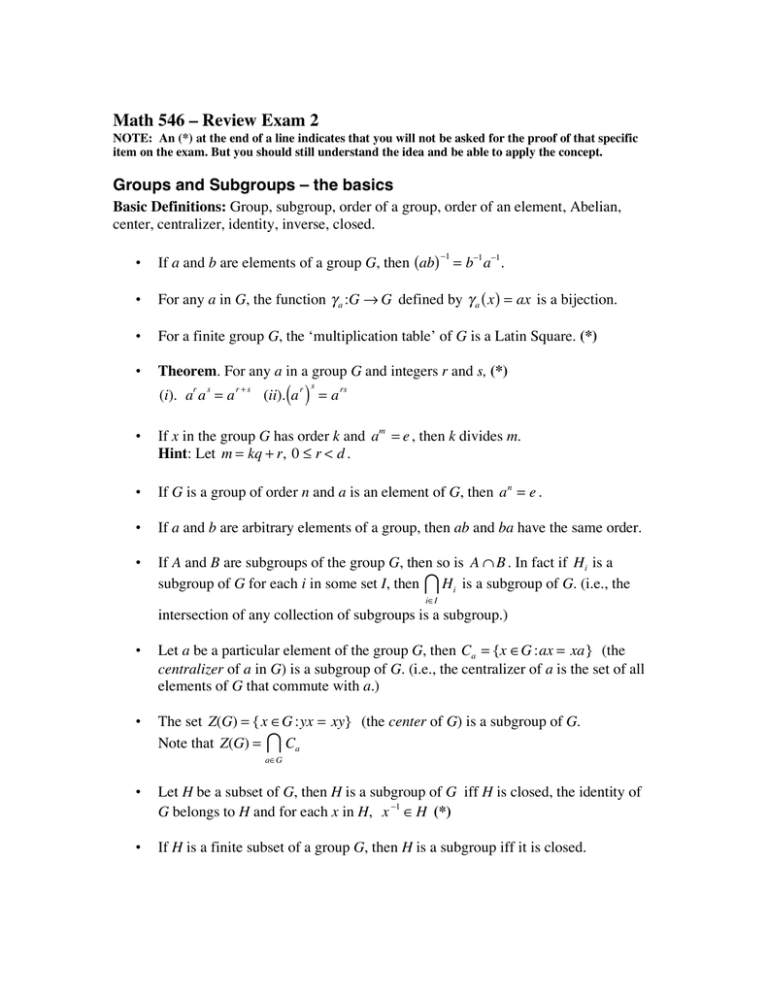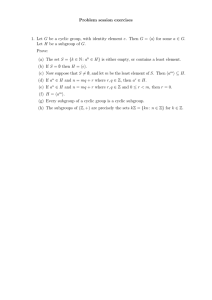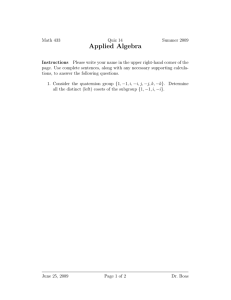Document
advertisement

Math 546 – Review Exam 2
NOTE: An (*) at the end of a line indicates that you will not be asked for the proof of that specific
item on the exam. But you should still understand the idea and be able to apply the concept.
Groups and Subgroups – the basics
Basic Definitions: Group, subgroup, order of a group, order of an element, Abelian,
center, centralizer, identity, inverse, closed.
•
If a and b are elements of a group G, then (ab) = b!1 a!1 .
•
For any a in G, the function ! a :G " G defined by ! a ( x ) = ax is a bijection.
•
For a finite group G, the ‘multiplication table’ of G is a Latin Square. (*)
•
Theorem. For any a in a group G and integers r and s, (*)
!1
(i). ar a s = a r + s (ii).(a r ) = a rs
s
•
If x in the group G has order k and am = e , then k divides m.
Hint: Let m = kq + r, 0 ! r < d .
•
If G is a group of order n and a is an element of G, then a n = e .
•
If a and b are arbitrary elements of a group, then ab and ba have the same order.
•
If A and B are subgroups of the group G, then so is A ! B . In fact if Hi is a
subgroup of G for each i in some set I, then ! Hi is a subgroup of G. (i.e., the
i!I
intersection of any collection of subgroups is a subgroup.)
•
Let a be a particular element of the group G, then Ca = {x !G :ax = xa} (the
centralizer of a in G) is a subgroup of G. (i.e., the centralizer of a is the set of all
elements of G that commute with a.)
•
The set Z(G) = { x !G :yx = xy} (the center of G) is a subgroup of G.
Note that Z(G) = ! Ca
a!G
•
Let H be a subset of G, then H is a subgroup of G iff H is closed, the identity of
G belongs to H and for each x in H, x !1 " H (*)
•
If H is a finite subset of a group G, then H is a subgroup iff it is closed.
Exercises
1. If A and B are subgroups of the abelian group G with A = n, B = m where n
and m are relatively prime integers, then show that AB = nm .
[ Recall that AB = {ab : a !A,!b !B} ]
Hint: It is enough to show that the function f :A ! B " AB , defined by
f (a,b) = ab is a bijection.
Solution: It is enough to show that the function f :A ! B " AB , defined by
f (a,b) = ab is a bijection.
So, suppose that f (a1,b1 ) = f (a2 ,b2 ) . We must show that
(a1 ,b1 ) = (a2 ,b2 ) ! a1 = a2 and b1 = b2 .
But since, f (a1,b1 ) = f (a2 ,b2 ) , then a1b1 = a2 b2 ! a1 a2 "1 = b2b1"1 . But that means
that the element x = a1 a2 !1 = b2 b1 !1 belongs both to A and to B. Thus the order of x
must divide both n and m. But that means that x must have order 1, in other words
that x is the identity. Hence a1 a2 !1 = e = b2b1!1 " a1 = a2 and b1 = b2 .
2. In Q8 , let A = {i,! j},!!B = {!1,!i} what is AB ?
Solution: AB = {!i,!! j,!!1,!!k} .
3. If G is a group and x 2 = e for every x in G, then G is abelian.
Solution: Let a and b be any elements of G. Then
(ab) 2 = e ! abab = e ! a(abab) = ae ! bab = a ! b(bab) = ba ! ab = ba.
4. Suppose that G contains exactly one element a of order 2. Show that a belongs to
the center of G. Hint: for any x in G consider ( xax !1 ) . Give an example of a
group that has exactly one element of order 2.
2
Solution: ( xax !1 ) = (xax !1 )( xax !1) = xa(x !1 x)ax !1 = xa2 x !1 = xx !1 = e .
Hence either xax !1 = e " a = e , which is impossible since a has order 2, or xax !1
has order 2 in which case xax !1 = a " xa = ax . Thus a commutes with x and
since x was arbitrary, that means that a commutes with every element of G. Hence
a belongs to the center of G.
2
5. If G is an abelian group, then H = {x :x 2 = e} is a subgroup of G.
Solution: Clearly, since e 2 = e, e belongs to H. Suppose that a and b are elements
of G. Then (ab) 2 = abab = aabb = ee = e . Hence ab ! H , so H is closed. Finally,
2
!1
suppose that x is any element of H, then ( x !1 ) = x !2 = ( x 2 ) = e !1 = e and so
x !1 "H .
6. For real numbers a, b let Ta,b (x) = ax + b.
F = {Ta,b : a,b are real numbers } is a group under composition of functions.
Solution: This follows from the parts below.
Ta,b !Tc ,d = T?,?
Solution:
Ta,b !Tc ,d (x) = Ta,b (Tc,d (x)) = Ta,b (cx + d) = a(cx + d) + b = acx + ad + b = Tac,ad + b (x)
And so, Ta,b !Tc ,d = Tac,ad +b which is in F and so F is closed.
What is the identity of F?
Solution:
From the lines above, Ta,b !T1,0 = Ta,b = T1,0 ! Ta,b , and so the identity is T1,0 .
(T )
a,b
!1
= T1 ,! b
a
a
Solution: (Just try it.)
H = {Ta,b : a,b are real numbers, a is rational } is a subgroup of F.
Cyclic Groups
Basic Definitions: generator, cyclic group, G = < g >.
•
Every cyclic group is commutative.
•
If G and H are any cyclic groups of order n, then G is isomorphic to H (*)
Consequently, every cyclic group on n elements is isomorphic to Zn (*)
•
The only infinite cyclic group (up to isomorphism) is the integers under addition (*)
•
Every subgroup of a cyclic group is cyclic.
•
If k ! Zn is relatively prime to n, then k generates (Zn ,+) (*)
•
For a cyclic group G = g of order n, G = {e,!e2 ,!…,,!en !1 } .(*)
LaGrange’s Theorem and Its Consequences
•
Theorem (LaGrange). Let G be a finite group of order n and H a subgroup of
order k, then k divides n (*)
•
So, G = H [G:H ] , where [G :H ] =
G
is the index of H in G (*)
H
•
For any subgroup H of the group G, the relation x ! y mod H " x #1 y $H is an
equivalence relation. The equivalence class of any element x of G is [x] = xH the
left coset of x in G.
•
The cardinality of any left coset xH is the same as that of H.
•
If x is an element of the finite group G then the order of x divides the order of G.
•
If G is a group of prime order, then G is cyclic.
•
Theorem (Euler) If a and n are positive, relatively prime integers, then
a!( n ) " 1 mod n .
•
Theorem (Fermat) If n, p! Z + , p is a prime and p/ /| n , then a p !1 " 1 mod p.
(Note: p/ /| n means that p does not divide n.)
Exercises
1. Let A and B be subgroups of G with A = n, B = m where n and m are relatively
prime integers. Then show that A ! B = {e}.
Solution: suppose that a belongs to both A and B. Then the order of a must divide
both n and m and hence the order of a is 1 and so a is the identity.
2. Show that if G is an abelian group of order 2n, and n is odd, then G has exactly
one element of order 2. (This uses LaGrange’s Theorem.)
Hint: We know from a previous exercise that G must contain at least one element
of order 2. You need to show here that there cannot be another one.
Solution: Suppose that G has (at least) two distinct elements a and b of order 2.
We will show that this produces a contradiction. Then it is easy to check that
H = {e, a, b, ab} is a subgroup of G. (Recall that if H is a finite subset of a group,
then it is a subgroup iff it is closed.)
Hence, by LaGrange’s Theorem, H divides G . Hence 4 divides 2n which is
impossible since n is odd.
3. (a). List all the left cosets of {-1, 1} in the Quaternions.
(b). What is the order of i in the Quaternions?
Solution: 4.
4. Suppose that G is a finite group and K is a subgroup of H and H is a subgroup of G.
Then show that [G : K ] = [G : H ][H : K ] .
Solution: See problem set 15.
Permutations, Permutation Groups and Cayley’s Theorem
Basic Definitions: permutation, cycle, transposition. Be able to express a permutation as
a product of disjoint cycles. Be able to find powers and the inverse of a given
permutation.
•
If ! , " are disjoint cycles, then ! " = " ! (*)
•
Every permutation is the product of disjoint cycles and this representation is
unique up to the order of the factors (*)
•
If a permutation is written as a product of disjoint cycles, then its order is the the
least common multiple of the lengths of the cycles.
Example: The order of (1,!5,!4 ) (7,!3,!2,!8) is 12, the order of ( 3,!4 ) ( 5,!7,!1) is 6,
and the order of ( 3,!5 ) ( 2,!1,!4 ) ( 6,!8,!7 ) ( 9,!10 ) is 6.
Exercises
1. Find a permutation ! such that ! (1, 2, 3, 4) = (3,1, 2, 4).
Solution: ! = (3,1,2,4)( 4,3,2,1) = (1,3,4 )
2. Find a permutation ! " S8 that is not a cycle and such that ! 3 = (1, 2, 3, 4) 3 .
Solution: We may choose ! = (1, 2, 3, 4)(5, 6, 7) .
3. (a). What is the order of ! = ( 3,!1,!6,!5,!7 ) "S8 .
" 1 2 3 4 5 6 7 8%
(b). Express ! = $
as a product of disjoint cycles.
# 4 5 1 3 7 2 8 6 '&
(c). What is ! 2 ?!!! 3 ?
" 1 2 3 4 5 6 7 8%
(c). Let ! = $
. What is the product !" ?
# 5 3 1 2 6 4 8 7 '&
4. How many distinct r-cycles with r < n are there in Sn ?
Hint: The number of distinct ways to arrange r objects in a circle is (r ! 1)!
! n$
! n$
Solution: # & (r ' 1)! So, in particular, there are # & transpositions.
" r%
" 2%
5. Let a be an integer in {1, 2, 3, …, n}, then show that H a = {! :! (a) = a} is a
subgroup of Sn .
Solution: Just do it.
6. (a). Show that every cycle is a product of transpositions.
Hint: (1,!2,!3,!4 ) = (1,!4 ) (1,!3) (1,!2 ) .
(b). Show that every permutation is a product of transpositions.
Solution: A simple consequence of the the fact hat every permutation is a product
of cycles.
7. What is the index of (1,!2,!3) ( 4,!5 ) in S8 ?
Solution: 8 ! 7 ! 6 ! 5 ! 4 = 6720 .
8. Show that if ! "S5 , then ! 120 = i (i is the identity permutation).
Note that this was originally posted as ! "S9 .
Solution: The order of S5 is 120.
Can you show that there is a ! "S9 for which the conclusion in (8) fails?
9. (a). Does there exist an element of order 15 in S12 ?
Solution: Yes, for example (1,!2,!3)(4,!5,!6,!7,!8) .
(b). Does there exist an element of order 13 in S12 ?
Solution: No. If there were such an element then 13 would have to divide 12!
10. (Harder) What is the centralizer of (1,!2 ) in S4 ?
Solution: You can verify that
C [ (1,!2)] = {! "S4 : ! (1) = 1 and ! (2) = 2!or!! (1) = 2 and ! (2) = 1 } .
Isomorphisms
1. Show that f :( R, + ) ! (C* , ") defined by f (x) = cos x + isin x is an isomorphism.
Hint: use the relations
cos(x + y) = cos x cos y ! sin x sin y, sin(x + y) = sin x cos y + sin y cos x .
Solution: The hint tells it all.
2. Let G be a group of order n and m an integer relatively prime to n. Show that the
function f :G ! G, defined by f (x) = x m is a bijection. Determine a condition on
G that would make f a homomorphism as well.
Hint: Show that f is onto – then it will also be 1-1 since G is finite.
Solution: Let a and b be integers such that an + bm = 1.
Then for any y in G, y = y an +bm = (y n ) a (y b ) m = (y b )m = f (y b ) and so since y was
arbitrarily chosen in G, f is onto.
The Euler phi-function.
•
! ( p) = p " 1, and ! ( p n ) = ( p " 1)p n "1 where p is a prime(*)
•
! (nm) = ! (n)! (m) if n and m are relatively prime. (*)
•
If p is a prime and a and b are integers and p divides ab, then p divides a or p
divides b.(*)
•
If n and m are relatively prime, then there exist integers a and b such that
an + bm = 1.
•
For any positive integers n and d there exists integers q and 0 ! r < d , such that
n = dq + r .(*)





